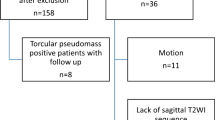Abstract
Background
Incidental findings on brain MRI may constitute a diagnostic pitfall. We observed an incidental extra-axial midline rounded pseudomass between the torcular Herophili and the occipital squama, with spontaneous resolution, which we called “torcular pseudomass.”
Objective
We investigated the frequency, imaging features, natural history and developmental background of this finding in a large group of infants and young children.
Materials and methods
We conducted a single-center retrospective study by reviewing all brain MRIs performed in children younger than 3 years between 2007 and 2013 in a specialized pediatric hospital. We looked for soft tissue (minimum 2 mm thick) interposed between the torcula and the occipital squama on midsagittal T1 and T2 images; we recorded the maximal diameters and outcome.
Results
Of 2,283 the children who had brain MRIs during the study period, 291 (12.7%, 95% confidence interval [CI] 0.11, 0.14) presented with a torcular pseudomass (median age 4 months, range 0 days to 35 months, 56% male). MRI features were the same in all of these children: T1 isointensity and T2 hyperintensity to the cerebral cortex, facilitated diffusion on diffusion-weighted imaging and apparent diffusion coefficient maps, and contrast enhancement. The median diameters were: anteroposterior, 5.8 mm; transverse, 10.5 mm; cranio-caudal, 20.6 mm. Follow-up MRI was available in 34.7% (95% CI: 0.20, 0.40) of the children; median follow-up time was 18 months. Among these children, 35.6% (95% CI: 0.26, 0.45) had total involution, 52.5% (95% CI: 0.26, 0.62) had partial involution and 4.1% (95% CI: 0.05, 0.18) showed stability.
Conclusion
Redundant soft tissue in the torcular region, or torcular pseudomass, is not an infrequent finding in infants and young children. It should be considered a physiological tissue, reflecting the postnatal developmental process of the brain and cranial vault, without the need for further investigation or follow-up imaging studies.







Similar content being viewed by others
References
Illes J, Kirschen MP, Edwards E et al (2006) Ethics. Incidental findings in brain imaging research. Science 311:783–784
Malova M, Rossi A, Severino M et al (2016) Incidental findings on routine brain MRI scans in preterm infants. Arch Dis Child Fetal Neonatal Ed. doi:10.1136/archdischild-2015-310333
Lacroix-Boudhrioua V, Linglart A, Ancel PY et al (2011) Pineal cysts in children. Insights Imaging 2:671–678
Illes J, Kirschen MP, Edwards E et al (2008) Practical approaches to incidental findings in brain imaging research. Neurology 70:384–390
Pedicelli S, Alessio P, Scire G et al (2014) Routine screening by brain magnetic resonance imaging is not indicated in every girl with onset of puberty between the ages of 6 and 8 years. J Clin Endocrinol Metab 99:4455–4461
Maher CO, Piatt JH Jr, Section on Neurologic Surgery AAoP (2015) Incidental findings on brain and spine imaging in children. Pediatrics 135:e1084–e1096
Mowbray K (2005) Surface bone histology of the occipital bone in humans and chimpanzees. Anat Rec B New Anat 283:14–22
Bernard S, Loukas M, Rizk E et al (2015) The human occipital bone: review and update on its embryology and molecular development. Childs Nerv Syst 31:2217–2223
Tubbs RS, Bosmia AN, Cohen-Gadol AA (2012) The human calvaria: a review of embryology, anatomy, pathology, and molecular development. Childs Nerv Syst 28:23–31
Adeeb N, Mortazavi MM, Tubbs RS et al (2012) The cranial dura mater: a review of its history, embryology, and anatomy. Childs Nerv Syst 28:827–837
Patel N, Kirmi O (2009) Anatomy and imaging of the normal meninges. Semin Ultrasound CT MR 30:559–564
Standring S (2008) Gray’s anatomy: the anatomical basis of clinical practice, 40th edn. Churchill Livingstone, Philadelphia
Nabeshima S, Reese TS, Landis DM et al (1975) Junctions in the meninges and marginal glia. J Comp Neurol 164:127–169
Nayak SR, Krishnamurthy A, Madhan Kumar SJ et al (2007) The mendosal suture of the occipital bone: occurrence in Indian population, embryology and clinical significance. Surg Radiol Anat 29:329–332
Tubbs RS, Salter EG, Oakes WJ (2007) Does the mendosal suture exist in the adult? Clin Anat 20:124–125
Shapiro R, Robinson F (1976) Embryogenesis of the human occipital bone. AJR Am J Roentgenol 126:1063–1068
Rayssiguier R, Dumont C, Flunker S et al (2014) Thrombosis of torcular herophili: diagnosis, prenatal management, and outcome. Prenat Diagn 34:1168–1175
Byrd SE, Abramowicz JS, Kent P et al (2012) Fetal MR imaging of posterior intracranial dural sinus thrombosis: a report of three cases with variable outcomes. Pediatr Radiol 42:536–543
Merzoug V, Flunker S, Drissi C et al (2008) Dural sinus malformation (DSM) in fetuses. Diagnostic value of prenatal MRI and follow-up. Eur Radiol 18:692–699
Author information
Authors and Affiliations
Corresponding author
Ethics declarations
Conflicts of interest
None
Rights and permissions
About this article
Cite this article
Sampaio, L., Morana, G., Severino, M. et al. Torcular pseudomass: a potential diagnostic pitfall in infants and young children. Pediatr Radiol 47, 227–234 (2017). https://doi.org/10.1007/s00247-016-3734-4
Received:
Revised:
Accepted:
Published:
Issue Date:
DOI: https://doi.org/10.1007/s00247-016-3734-4




